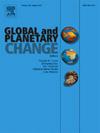A decrease in low-latitude weathering flux facilitated the demise of the Late Paleozoic Ice Age
IF 4
1区 地球科学
Q1 GEOGRAPHY, PHYSICAL
引用次数: 0
Abstract
The Late Paleozoic Ice Age (LPIA) was a series of modulated glacial-interglacial pulses that characterized the climate of the late Carboniferous through Permian. Although the ages and durations of the main major episodes of the LPIA have been calibrated from glacial deposits in eastern Australia and elsewhere, the causal factors for the final transition from the oscillating icehouse climate to a continuous hothouse remains uncertain. To aid in unraveling the potential causes for this climatic turnover and its characteristics in the tropical latitudes, we measured the weathering indices and redox proxies recorded by the Lopingian (Late Permian) strata in the Shangsi section of the Upper Yangtze region in South China. The multiple weathering indices derived from the geochemical composition of the acid-insoluble residues in the carbonate rocks exhibit consistent trends. These trends, when combined with published coeval weathering data from other regions, trace four global phases of weathering changes during the late Permian. After the middle Wuchiapingian, the observed increase in the weathering indices and a negative excursion in carbon isotope are apparent responses to gradual warming. The simultaneous increase in ocean oxygenation may have also played a role in the deglaciation. Based on the changes in tropical exposed land area through the late Permian, we quantitatively estimated the low-latitude chemical weathering flux by combining contemporaneous weathering indicators. The curve of that estimated flux support the hypothesis that a sustained decrease in low-latitudes weathering flux, the implied apparent decrease in the amount of exposure and total weathering of silicate rocks, may caused a weakening of the carbon sink and a continuous accumulation of atmospheric CO2, which in turn facilitate the stepwise deglaciation of LPIA and the onset of a long-term hothouse climate.
求助全文
约1分钟内获得全文
求助全文
来源期刊

Global and Planetary Change
地学天文-地球科学综合
CiteScore
7.40
自引率
10.30%
发文量
226
审稿时长
63 days
期刊介绍:
The objective of the journal Global and Planetary Change is to provide a multi-disciplinary overview of the processes taking place in the Earth System and involved in planetary change over time. The journal focuses on records of the past and current state of the earth system, and future scenarios , and their link to global environmental change. Regional or process-oriented studies are welcome if they discuss global implications. Topics include, but are not limited to, changes in the dynamics and composition of the atmosphere, oceans and cryosphere, as well as climate change, sea level variation, observations/modelling of Earth processes from deep to (near-)surface and their coupling, global ecology, biogeography and the resilience/thresholds in ecosystems.
Key criteria for the consideration of manuscripts are (a) the relevance for the global scientific community and/or (b) the wider implications for global scale problems, preferably combined with (c) having a significance beyond a single discipline. A clear focus on key processes associated with planetary scale change is strongly encouraged.
Manuscripts can be submitted as either research contributions or as a review article. Every effort should be made towards the presentation of research outcomes in an understandable way for a broad readership.
 求助内容:
求助内容: 应助结果提醒方式:
应助结果提醒方式:


